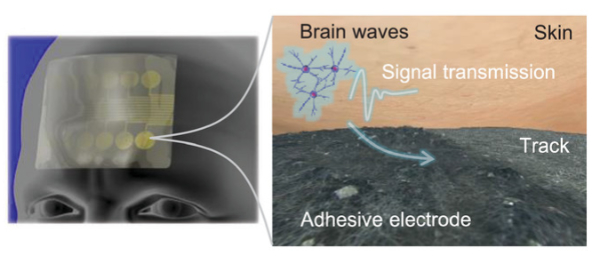Medtech
A New Wearable Measures Brain Activity
If you’ve ever had a brain scan, or even just seen one on TV, you probably know that it’s kind of a big deal. Measuring brain activity usually involves…


If you’ve ever had a brain scan, or even just seen one on TV, you probably know that it’s kind of a big deal. Measuring brain activity usually involves functional magnetic resonance imaging (fMRI) — that’s when the patient goes into the big humming tube — or electroencephalography (EEG), in which electrodes are attached to the scalp. It could also mean electrocorticography (ECoG), a surgical procedure in which an electrode is placed under the scalp. But what if there was a much simpler way to measure brain activity? One that doesn’t require a clinical setting, much less an invasive surgery? There just might be. Researchers at Japan’s Osaka University have developed an EEG wearable that can measure brain activity in everyday settings.
Light, stretchable, and transparent, the sheet-type sensor attaches to the forehead to wirelessly monitor brain waves, recording EEGs, without physical discomfort for the wearer. And with accuracy that’s comparable to medical-grade equipment, according to the findings of a study published in Advanced Materials Technologies. The study’s lead author Teppei Araki says, “We were able to fuse together organic and inorganic materials to create a stretchable and transparent sensor sheet that can be worn on the forehead, is gentle to the skin, and is invisible to the eye. Unlike conventional wearable devices, our multifunctional electrode system has medical device-like performance, is easy to apply, and is comfortable to wear for long periods of time.”
And the device has potential use that goes far beyond basic brain monitoring. Researcher Tsuyoshi Sekitani explains, “It can potentially be used to remotely assess many other health indicators, such as electrocardiograms, pulse waves, blood oxygen saturation, or blood flow.” The study points out that the sensor sheet can be used for remote photoplethysmography (rPPG), an optical way to measure pulse rate and blood oxygen saturation by detecting changes in the skin. And laser Doppler flowmetry (LDF), a continuous and non-invasive way to measure tissue blood flow.
Of course, we already have wearables that can measure many of the additional vital signs that the new sheet-type sensor could track, making the EEG aspect all the more notable. As the study posits, “If brain activity could be monitored easily at home, like body temperature, blood pressure, and weight, then the signs of severe diseases could be recognized before their onset.”

ETF Talk: AI is ‘Big Generator’
Second nature comes alive Even if you close your eyes We exist through this strange device — Yes, “Big Generator” Artificial intelligence (AI) has…
Apple gets an appeals court win for its Apple Watch
Apple has at least a couple more weeks before it has to worry about another sales ban.
Federal court blocks ban on Apple Watches after Apple appeal
A federal appeals court has temporarily blocked a sweeping import ban on Apple’s latest smartwatches while the patent dispute winds its way through…














